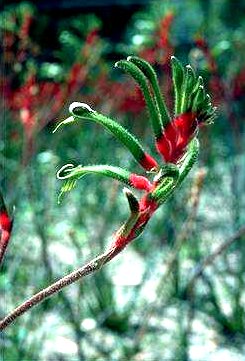 |
It is one of about twelve species
of the genus Anigozanthos which is restricted to the south-west
of Western Australia. The family Haemodoraceae to which it belongs occurs
in Australia, Papua New Guinea, South Africa and the Americas.
The author of the genus was the French botanist, Jacques-Julian Houton de Labillardiere, who was the first to collect the kangaroo paw, Anigozanthos rufus, near Esperance in 1792. The generic name Anigozanthos is probably derived from the Greek 'anises', meaning 'unequal' or 'oblique', and 'anthos', meaning 'flower', in reference to the division of the floral extremities into six unequal parts. The specific name, manglesii, honours Robert Mangles who raised the type specimen from seed in his English garden. The common name, kangaroo paw, is derived from the appearance of the unopened cluster of flowers. In appearance, Red and Green Kangaroo Paw is a low sub-shrub growing from an underground stem. Its broad leaves are about 30 to 60 cm long and taper to an acute apex. The flowering stem grows to about a metre in height and is often forked in specimens from the northern part of the species' range. The stem and the bases of the flowers are usually deep red and covered with woolly hairs. The colour changes abruptly to a brilliant green for the greater length of the flower which splits open revealing the smooth pale green interior. |
 In
its natural habitat Red and Green Kangaroo Paw flowers between August and
October, depending on seasonal conditions and locality. It occurs naturally
in heath on sandy soil from the Murchison River in the north to Busselton
and Mount Barker in the south and Lake Muir to the east. In the Darling
Range it occurs in heath on gravelly soils of lateritic origin.
In
its natural habitat Red and Green Kangaroo Paw flowers between August and
October, depending on seasonal conditions and locality. It occurs naturally
in heath on sandy soil from the Murchison River in the north to Busselton
and Mount Barker in the south and Lake Muir to the east. In the Darling
Range it occurs in heath on gravelly soils of lateritic origin.